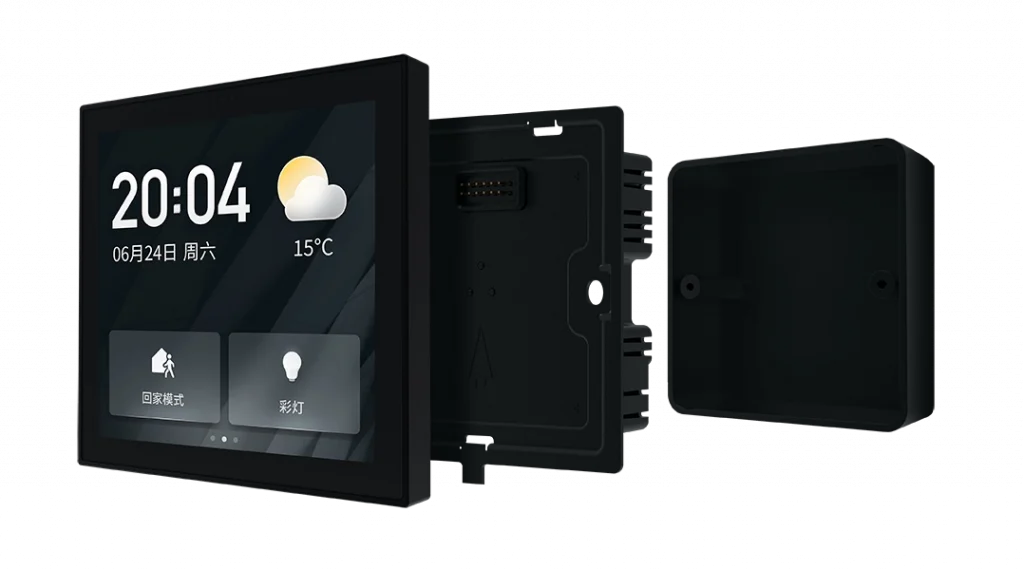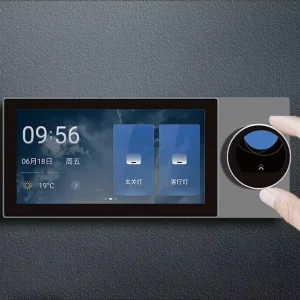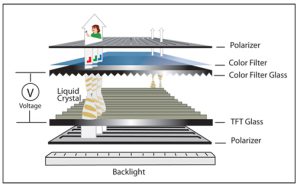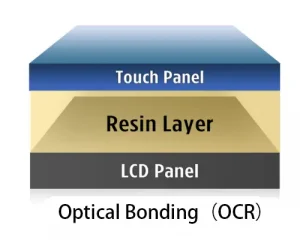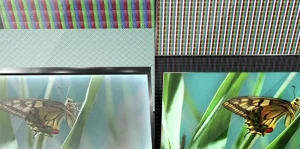Smart home technology has undergone a dramatic evolution over the last decade, particularly in China. In cities and urban areas across the country, intelligent living is no longer a luxury — it is fast becoming a standard. This revolution is fueled by the integration of home automation systems, connected appliances, and advanced interfaces that offer convenience, efficiency, and comfort to end-users. A critical component enabling this wave of innovation is the compact yet capable 4.0-inch TFT LCD.
Compact in size yet rich in display capabilities, the 4.0-inch TFT LCD display is now at the center of a growing trend: Smart Control Panels that fit seamlessly into China’s standardized 86 box. This tiny screen is transforming how people interact with their homes, replacing traditional light switches with intelligent touch panels that manage lighting, climate, curtains, security, and even entertainment systems.
What Is the 86 Box Standard?
The 86 box is a wall-mounted electrical box commonly used across China. Named for its dimensions — 86mm by 86mm — this standard has defined how wall switches, sockets, and control panels are mounted for decades. It provides enough space to house mechanical switches, basic electronic modules, or, more recently, fully digital interfaces.
Traditionally, an 86 box houses 1–3 switch circuits, allowing for manual control of lighting or ceiling fans. However, with the rise of smart home technologies, manufacturers saw an opportunity to create touchscreen-based Smart Control Panels that could drop into existing infrastructure without needing to drill or rewire extensively. The 4.0-inch TFT LCD fits this need perfectly.
Why 4.0-Inch TFT LCD Is the Ideal Fit
There are various screen sizes used in smart home control devices, ranging from 3.5 inches to 7 inches. Yet, the 4.0-inch screen has emerged as a sweet spot — small enough to fit in constrained spaces, yet large enough to offer excellent visibility, touch interactivity, and a modern UI experience. Here’s why:
- It fits perfectly in a single 86 box with minimal frame or bezel.
- It supports square resolutions (480×480 or 720×720) ideal for balanced UI layouts.
- Its capacitive touch integration supports multi-touch gestures and swipe actions.
- It consumes low power, enabling 24/7 operation without excessive heat.
- Costs are relatively low due to mature TFT manufacturing processes.
Compared to 3.5-inch panels, the 4.0-inch display provides more room for interactive UI elements. And when compared to 4.3-inch displays, it has better compatibility with 86 box installations without requiring design modifications. It’s a balanced choice for most residential and light commercial environments.
RK040HF08: A Reliable 4.0-Inch Display Module
One standout product in this space is the RK040HF08 4.0-inch TFT LCD developed by Rocktech. This module offers superior optical performance with a resolution of 480×480 pixels, high brightness (typically above 500 nits), and a wide viewing angle thanks to its IPS panel. The display also supports capacitive multi-touch, making it suitable for gesture-based control interfaces.
The RK040HF08 is not just about visual performance. It is designed to withstand continuous operation in environments ranging from 0°C to 70°C, ensuring stability in home or office installations. With a lifetime exceeding 50,000 hours and optional support for optical bonding and anti-glare coating, it meets the demanding needs of today’s embedded smart applications.
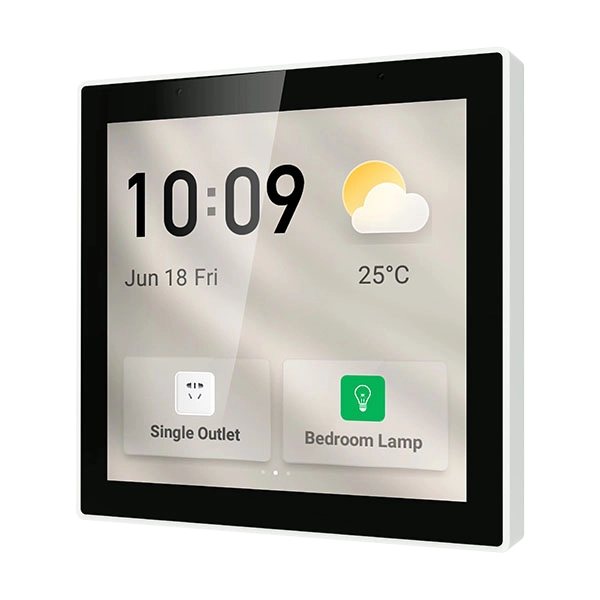
Smart Control Panel Applications
A 4.0-inch TFT-equipped Smart Control Panel can do far more than just replace a light switch. Depending on the system architecture and installed modules, these panels can control:
- Lighting: On/off, dimming, color temperature, RGB scenes
- Curtains: Motorized window treatment open/close or timed operation
- Climate: Fan speed, HVAC temperature, dehumidification
- Security: Arm/disarm, motion detection, door lock control
- Video Intercom: Two-way audio, video preview from smart doorbells
- IoT Sensors: Display PM2.5, CO₂, humidity, and temperature data
Furthermore, the panel can serve as a gateway or edge node in a smart home mesh network, using Zigbee, BLE, or Wi-Fi connectivity to coordinate with hundreds of IoT devices. With the addition of a well-optimized UI running on Android, Linux, or RTOS, the 4.0-inch screen becomes the face of the home automation system.
Industry Ecosystem and Adoption
Major players across multiple industries are rapidly integrating Smart Control Panels into their offerings:
- Home appliance brands like Midea, Haier, and Gree embed HVAC and appliance controls into wall panels.
- Lighting giants such as Opple and Leishi bundle smart lighting solutions with their own touchscreen switches.
- Security providers use these panels to merge intercom, locks, and alarms into one interface.
- Real estate developers pre-install panels in new properties to increase their smart home appeal.
- IoT platforms like Tuya and LifeSmart enable white-label customization for local OEMs.
China’s Smart Home Explosion
China’s smart home market is expanding at double-digit growth rates annually. With rising urban income levels, government support for intelligent infrastructure, and consumer demand for automation, the number of connected households has skyrocketed.
Smart Control Panels — particularly those using 4.0-inch displays — are becoming the control hub in these homes. They offer a familiar and accessible location (next to the door, kitchen, or bedroom), allowing users to interact with their environment without pulling out a phone or using voice commands. In multi-resident buildings, these panels are even integrated into community-wide systems, enabling door access, elevator calling, and energy monitoring.
Future Trends
The evolution of the 4.0-inch TFT panel is far from over. Emerging trends include:
- Integration with AI voice agents and face recognition cameras
- Use of curved glass and bezel-less designs for premium appearance
- In-panel sensors (proximity, ambient light) for dynamic UI adaptation
- Support for Matter, Apple HomeKit, and cross-platform standards
As component costs decline and user expectations rise, 4.0-inch smart interfaces will shift from luxury to necessity in modern living.
Conclusion
The 4.0-inch TFT LCD is the unsung hero behind today’s Smart Control Panels. Its ability to combine clarity, compactness, and cost-effectiveness makes it the ideal choice for Chinese homes that rely on the 86 box standard. With leading models like RK040HF08 setting the benchmark, it’s clear that the era of wall-mounted intelligence is just beginning.
Integrating Voice Control in Smart Panels
As smart homes continue to evolve, touchscreen control alone is no longer enough. Modern Smart Control Panels are now being configured with voice recognition capabilities, enabling hands-free interaction for lighting, curtains, HVAC, and more. This functionality is particularly important in scenarios where users have their hands full or for accessibility support.
In China, two of the most widely adopted voice AI providers are iFLYTEK and AISpeech. These companies offer embedded voice recognition modules that can be integrated directly into control panels running on Linux or Android systems. Their SDKs support Mandarin, regional dialects, wake-word detection, and offline speech recognition — a crucial feature for maintaining responsiveness even without stable internet connections.
With voice control, users can issue commands like “Turn off all lights,” “Close the curtains,” or “Set the temperature to 26 degrees” — all without touching the panel. When combined with a 4.0-inch TFT LCD for visual feedback, this creates a hybrid interface that blends the best of both touch and voice interaction.
4.0-Inch vs. Larger Displays: A Strategic Comparison
Some manufacturers may wonder whether to use 4.3″, 5″, or even 7″ displays in their wall-mounted panels. While larger screens offer more space for UI elements, they also introduce several drawbacks:
- Size incompatibility: 7-inch displays require new installation boxes or surface mounting, which increases cost and complexity.
- Higher power consumption: Larger LCDs need stronger backlights and draw more power, which may be impractical for always-on panels.
- Overkill for simple functions: Many smart home controls require only a small set of options, making large screens unnecessary.
The 4.0-inch display remains optimal for minimalistic yet functional interfaces — especially in spaces where aesthetics, cost, and retrofitting matter.
Commercial and Public Applications
Beyond private homes, 4.0-inch smart panels are increasingly being deployed in:
- Hotels: For room control, scene lighting, DND/makeup room status, and service requests.
- Rental apartments: Centralized control of lighting and door locks without needing a full smart home hub.
- Offices: Wall panels in meeting rooms for scheduling, lighting, and air-conditioning control.
- Educational facilities: Smart classrooms using panels for environment control and access management.
Each of these use cases benefits from the compact design, reliability, and customization options that a 4.0-inch TFT LCD offers. Paired with voice control and connected to cloud platforms, they become powerful yet unobtrusive interfaces for users across industries.
Software Platforms and Driver Integration
To function as a reliable smart interface, the display module must be supported by a solid software stack. Most manufacturers rely on Android or embedded Linux platforms for their smart panel OS. Drivers for the 4.0-inch TFT LCD, such as the RK040HF08, are readily available for integration into standard BSPs (Board Support Packages) provided by SoC vendors like Rockchip PX30 and Allwinner R528.
Graphical UIs are often built using frameworks such as:
- LVGL: A lightweight GUI library perfect for RTOS and embedded Linux systems.
- Qt: Offers rich graphical interfaces, scalable from small to large displays.
- Android XML UIs: Common for app-style interfaces with advanced multimedia and animations.
Rocktech provides full documentation and reference design support for integrating their 4.0-inch TFT modules with these software platforms, making it easier for developers to shorten time-to-market and ensure stable long-term performance.
Conclusion: A Gateway to Smarter Living
The rise of smart home technology is transforming the way we live, and at the center of this revolution lies a surprisingly modest component — the 4.0-inch TFT LCD. Compact, powerful, and perfectly sized for China’s 86 box standard, it empowers Smart Control Panels to deliver next-generation control without altering the architecture of our homes.
With enhanced UI design, capacitive touch, voice integration via iFLYTEK or AISpeech, and native support for Android and Linux systems, the 4.0-inch TFT LCD (such as the RK040HF08) is more than a screen — it’s the intelligent core of tomorrow’s home interface.

